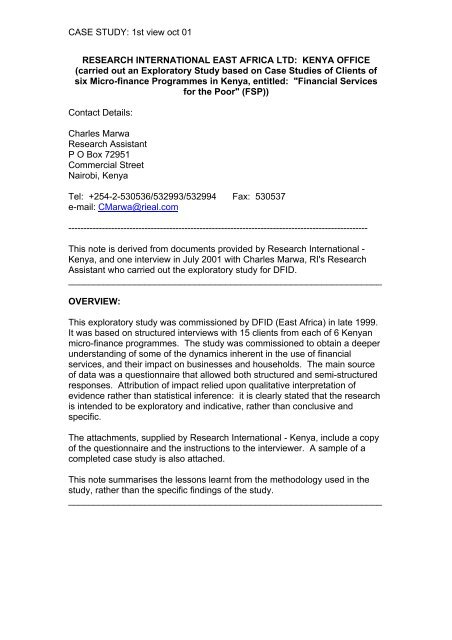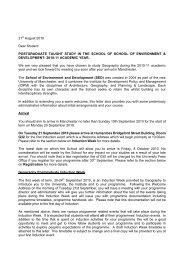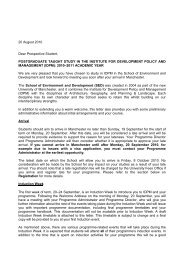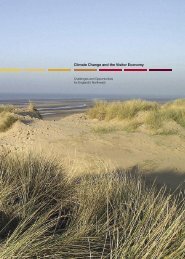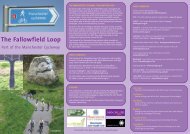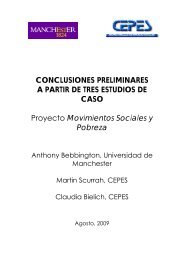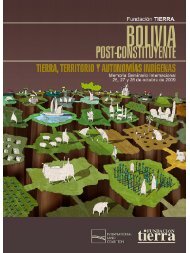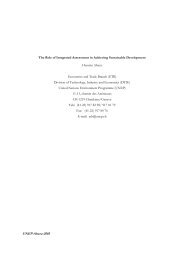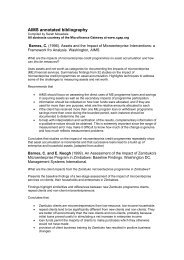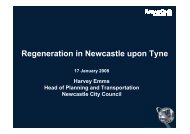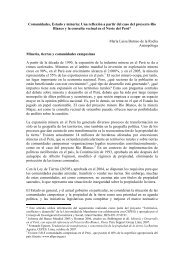RESEARCH INTERNATIONAL EAST AFRICA LTD: KENYA OFFICE
RESEARCH INTERNATIONAL EAST AFRICA LTD: KENYA OFFICE
RESEARCH INTERNATIONAL EAST AFRICA LTD: KENYA OFFICE
Create successful ePaper yourself
Turn your PDF publications into a flip-book with our unique Google optimized e-Paper software.
CASE STUDY: 1st view oct 01<br />
<strong>RESEARCH</strong> <strong>INTERNATIONAL</strong> <strong>EAST</strong> <strong>AFRICA</strong> <strong>LTD</strong>: <strong>KENYA</strong> <strong>OFFICE</strong><br />
(carried out an Exploratory Study based on Case Studies of Clients of<br />
six Micro-finance Programmes in Kenya, entitled: "Financial Services<br />
for the Poor" (FSP))<br />
Contact Details:<br />
Charles Marwa<br />
Research Assistant<br />
P O Box 72951<br />
Commercial Street<br />
Nairobi, Kenya<br />
Tel: +254-2-530536/532993/532994 Fax: 530537<br />
e-mail: CMarwa@rieal.com<br />
--------------------------------------------------------------------------------------------------<br />
This note is derived from documents provided by Research International -<br />
Kenya, and one interview in July 2001 with Charles Marwa, RI's Research<br />
Assistant who carried out the exploratory study for DFID.<br />
______________________________________________________________<br />
OVERVIEW:<br />
This exploratory study was commissioned by DFID (East Africa) in late 1999.<br />
It was based on structured interviews with 15 clients from each of 6 Kenyan<br />
micro-finance programmes. The study was commissioned to obtain a deeper<br />
understanding of some of the dynamics inherent in the use of financial<br />
services, and their impact on businesses and households. The main source<br />
of data was a questionnaire that allowed both structured and semi-structured<br />
responses. Attribution of impact relied upon qualitative interpretation of<br />
evidence rather than statistical inference: it is clearly stated that the research<br />
is intended to be exploratory and indicative, rather than conclusive and<br />
specific.<br />
The attachments, supplied by Research International - Kenya, include a copy<br />
of the questionnaire and the instructions to the interviewer. A sample of a<br />
completed case study is also attached.<br />
This note summarises the lessons learnt from the methodology used in the<br />
study, rather than the specific findings of the study.<br />
______________________________________________________________
CASE STUDY: 1st view oct 01<br />
1 BACKGROUND TO THE STUDYACKGROUND OF THE STUDY<br />
The British Aid to Small Enterprise (BASE) programme in Kenya has, since its<br />
inception, been strongly involved in the development of the micro-finance<br />
sector. In October 1997, following the review of earlier activities, a new fiveyear<br />
strategy for the programme was developed. One of the five outputs<br />
planned for the BASE Kenya programme over the five years 1997-2002 was<br />
“increased capacity of private sector providers to deliver financial services to<br />
micro-enterprises, particularly those owned by women and those in the rural<br />
areas, on a sustainable and replicable basis.” In support of this output,<br />
implementation of existing micro-finance projects continued and support was<br />
extended to further micro-finance activities. Consistent with both simplifying<br />
management arrangements and recognizing the need for a broader sectoral<br />
focus, all micro-finance support activities under BASE were incorporated into<br />
a new, larger umbrella project: Financial Services for the Poor (FSP)<br />
A number of BASE micro-finance projects, which were eventually subsumed<br />
within the FSP umbrella project, were time-tabled for mid-term output to<br />
purpose review in 1999. In order to both increase the efficiency of the review<br />
process itself and benefit from cross-project and sectoral learning a combined<br />
review of these projects was undertaken. Assessment of the impact of the<br />
FSP projects formed a key element of review.<br />
The overall purpose of the FSP review was to assess the progress of each of<br />
the DfID projects against the stated purpose and offer guidance for the<br />
implementation of the remaining elements of each project. In combining these<br />
project reviews, the aim was to draw lessons where appropriate from the<br />
comparative performance of each project and from examining the BASE<br />
micro-finance programme as a whole. This could be used both as a basis for<br />
assessing DfID’s broader involvement in the development of the micro-finance<br />
sector in Kenya and to guide future work. Clearly in drawing comparisons<br />
between projects it was essential to take account of the significant differences<br />
between them.<br />
A Research, Monitoring and Evaluation Project (REME) was established in<br />
1997 to assess the impact of BASE at both programme and individual project<br />
level. Although REME produced some outputs relating to projects falling<br />
under the FSP umbrella, as there was insufficient data at that time to attempt<br />
an assessment of the impact on target beneficiaries of these FSP projects.<br />
Furthermore, it was felt that there was insufficient understanding of the<br />
mechanisms by which FSP services make and impact, to be able to design a<br />
successful impact study.<br />
As such, this study was commissioned to obtain a deeper understanding of<br />
some of the dynamics inherent in use of financial services, and their impact<br />
on businesses and households. This report is a compendium of individual<br />
case studies. Each case study includes a narrative giving an overview of the<br />
story of the respondent and their use of services, an analysis against<br />
hypothesis, and key figures. The nature of the study is, however, to provide
CASE STUDY: 1st view oct 01<br />
the ‘raw’ information which can be used in further analysis and which can<br />
perhaps be expanded or followed up on as part of a longitudinal study.<br />
2 OBJECTIVES:<br />
The aims of the exploratory study were to: -<br />
Understand how different types of micro-finance services affect individual<br />
clients, their businesses and households.<br />
Provide information on impact and reaction to services of direct use to the<br />
Micro-Finance Institutions (MFIs) themselves.<br />
In terms of output the objective was to provide a number of in-depth case<br />
studies, which will form a platform for further analysis, expansion and followup<br />
over time.<br />
3 METHOD<br />
3.1 Background on method<br />
It is well established that the impact of access to micro-financial services<br />
cannot readily be understood by examining either the client or the business<br />
(for which a loan may ostensibly have been granted) in isolation. Rather<br />
clients are a part of a wider household and the business may be one of a<br />
number of income generating activities in which the household is engaged.<br />
The impact of access to financial services must be understood in terms of the<br />
effect on the wider household and livelihoods.<br />
In this study, attribution of impact relied upon qualitative interpretation of<br />
evidence, rather than statistical inference. Attribution of impact depends on<br />
understanding, from the client perspective, how each loan or use of a savings<br />
facility has impacted on aspects of their livelihoods. This research is<br />
essentially exploratory and is indicative of how various financial services can<br />
impact on livelihoods rather than conclusive regarding the specific aggregate<br />
impact of the various projects.<br />
3.2 Basic Approach<br />
Because of the complexity of the situation of the business and household, a<br />
qualitative, in-depth method of understanding was considered most<br />
appropriate. The study comprised in-depth interviews with selected clients<br />
using a research guideline incorporating both structured and unstructured<br />
questioning.
CASE STUDY: 1st view oct 01<br />
3.3 Sample selection<br />
Six MFIs were selected for the study. These were: K REP Bank<br />
• Faulu<br />
• WEDCO<br />
• KWFT: Kenyan Women's Finance Trust<br />
• Co-operative Bank (MSE unit)<br />
• K-REP NGO FSA: (Financial Services Association)<br />
All operate from Nairobi, except K-REP FSA and CARE-WEDCO whose<br />
operations are based in the remote parts of Taita-Taveta, Machakos,<br />
Marsabit, and Bomet Districts; and the Nyanza and Western regions of Kenya<br />
respectively.<br />
Between December 1997 and February 1998, the Institute of Development<br />
Studies (IDS), University of Nairobi, conducted a previous impact study, called<br />
REME. Under this REME study, four MFIs’ clients had been included; K-REP<br />
Bank, KWFT, Faulu, and WEDCO. The respondents interviewed within this<br />
FSP Exploratory Study, for these MFIs, were selected from the 300 who had<br />
been previously interviewed. The idea of selecting clients covered under<br />
REME was to allow for the possibility to assess and compare their perception<br />
in-terms of impact on their livelihood as a result of their interactions with the<br />
MFIs and how the loans were actually utilized over time.<br />
Since the K-REP FSA, and the Co-operative Bank had not taken part in the<br />
earlier REME study, fresh sampling had to be conducted to select their clients<br />
for the study. In this case, respondents were randomly selected from the<br />
current client list.<br />
Follow up of REME respondents was problematic. It was very difficult to track<br />
down these clients after such a long time. Some were completely untraceable,<br />
having changed their businesses and careers, migrated or even died. There<br />
were some who had married, and changed their names from the ones<br />
appearing on the list.<br />
3.4 Sample Structure<br />
Coast Mt Kenya Nairobi Machakos Western/Nyanza Total<br />
FAULU - 6 9 - - 15<br />
K-REP - - 15 - - 15<br />
WEDCO - - - - 16 15<br />
KWFT 4 5 6 - - 15<br />
K-REP 8 - - 7 - 15<br />
FSA<br />
Co-op bank<br />
MSE<br />
- 15 - - - 15
CASE STUDY: 1st view oct 01<br />
3.5 Field team<br />
To ensure that quality work was achieved, Research International (RI)<br />
selected a team of interviewers who were considered to be both<br />
knowledgeable and experienced enough, to be able to understand the job<br />
requirements. Most of the team members were University graduates with<br />
backgrounds as relevant as possible to the research subjects. Most were<br />
already experienced in field interviewing, and were selected from our Nairobi<br />
or Kisumu teams.<br />
3.6 Training<br />
Training of the interviewers took place within the premises in Nairobi and<br />
comprised four parts:<br />
<br />
<br />
<br />
<br />
In-depth interviewing skills for one day (trained by one of RI's Senior<br />
Qualitative Research Officers)<br />
Background on the area of Financial Services provision and impact,<br />
covering the sustainable livelihood framework (trained by the officer in<br />
charge of the project at DfID) – one day<br />
Application of the questionnaire – two days<br />
Following piloting, the interviewers underwent a further training session on<br />
the new questionnaire.<br />
The idea was to ensure that the team understood possible ways in which the<br />
financial services could impact on the poverty and vulnerability of clients and<br />
their households, to ensure in-depth probing and follow-up in relevant areas.<br />
They were also trained extensively on how to approach respondents and build<br />
up rapport that would lead to openness in response.
CASE STUDY: 1st view oct 01<br />
4 PILOTING<br />
After the training, the team was sent to the field for pre-test purposes. During<br />
this first trial, interviewers were paired together; one to be the facilitator and<br />
the other the note taker. From the experiences of this trial, the interview<br />
guideline was subsequently revised and strengthened. James Copestake, a<br />
financial sector consultant for DfID, joined the team for a few days and further<br />
worked towards improving the research tool. The teams wrote out their case<br />
studies and these were later sent to DfID for input and comment.<br />
5 FIELDWORK<br />
Nairobi, being the headquarters for most of the MFIs, had the highest<br />
concentration of respondents who were scattered in different parts of the city<br />
and conducted a variety of businesses. Thus the research started in Nairobi<br />
and lasted about eight days. Nyanza and Western regions were covered by<br />
the Kisumu based FSP team. From Nairobi, one half of the Nairobi based<br />
team went to the Coast whilst the other half went to cover the FSA in<br />
Machakos. Mt. Kenya region was the last to be reached.<br />
FSP field activities started on the 1 st of December 1999 and were concluded<br />
on the 14 th January 2000.<br />
The major problems encountered in the field were too long periods of time<br />
taken to locate some clients and delays occasioned by the rescheduling of the<br />
appointed interviews because the clients were very busy in their businesses.<br />
Other problems included clients who did not divulge correct information about<br />
their wealth status or other details. Some MFIs listings their projects as being<br />
in Nairobi, covered districts further away, including Machakos, Kitui and Thika.<br />
Tracking of sampled clients also had to be extended to such places. This cost<br />
considerable time.<br />
6 THE QUESTIONNAIRE<br />
The final interview guide / questionnaire is attached. This was designed in<br />
such a way as to allow respondents to express issues they felt important, and<br />
to collect basic facts and figures on households and business. As such it<br />
comprised a series of unstructured and structured questions. Interviewers<br />
were encouraged to probe throughout the questionnaire, even where an issue<br />
arose during a structured question, and to insert this additional information<br />
into the open sections.
CASE STUDY: 1st view oct 01<br />
7 ANALYSIS<br />
7.1 Case Study Structure<br />
The process of analysis of the case studies involved summarizing the life<br />
story of the respondent as told by them. This was constructed into a<br />
summarized, not verbatim, narrative. Following completion of the narrative, a<br />
separate analysis of each case was completed against the hypotheses<br />
agreed with DfID. The third part of each case comprises a table of key data.<br />
Information from the structured section of the questionnaire has been entered<br />
into an excel spreadsheet, which can be used for further analysis (see<br />
appendix).<br />
7.2 Analysis against Hypotheses<br />
RI agreed with DfID a set of hypotheses about the impact of financial<br />
services, against which each case study was `tested’. Looking at each<br />
interview, comparing qualitative and quantitative sections, observations and<br />
key data and then making a conclusion against each hypothesis was the<br />
methodology employed. This is in bullet form at the end of each narrative<br />
case history.<br />
The main hypotheses that this research will seek to explore are as follows:<br />
i) Impact on the poor<br />
Micro-finance services have been taken up by a highly diverse<br />
range of clients including many who are poor and many women.<br />
ii)<br />
Business Improvement<br />
Loans have helped some clients to diversify their business<br />
activities, to increase the capital invested in their businesses, to<br />
increase paid business employment, to increase business<br />
profitability and generally to decrease the vulnerability of the<br />
business to shocks.<br />
iii)<br />
Household livelihood Improvement<br />
The income of some clients has gone up enabling them to increase<br />
expenditure on food, health services, education, shelter and<br />
household assets and to cope with livelihood shocks.<br />
iv)<br />
Reduced household vulnerability<br />
The vulnerability of clients and clients’ households has been<br />
reduced by the increased security of incomes from business
CASE STUDY: 1st view oct 01<br />
activities or the creation of accessible financial assets to protect<br />
against risks and to cope with livelihood shocks.<br />
v) Increase in paid employment<br />
Loans have facilitated the expansion of some micro enterprises<br />
(which may be owned by non-poor clients) increasing the paid<br />
employment for the poor people.<br />
vi)<br />
Enhancing women’s status and livelihood<br />
Access to micro finance services has helped to strengthen the<br />
status and livelihood of women<br />
vii) Improved impact on the poor through developing the range<br />
and terms of financial services available.<br />
Impacts, particularly on the poor and on women can be improved<br />
through further developments of the range and terms of financial<br />
services on offer.<br />
A sample case study, including narrative and analysis against the above<br />
hypotheses is attached.<br />
8 SOME PROBLEMS FOUND WITH THE <strong>RESEARCH</strong>:<br />
When they came to be analysed, responses (sometimes contradictory, other<br />
times non-existent for some questions) revealed several problems with the<br />
research methodology, both the in the format of the questionnaire, and the<br />
way interviews were conducted. These included:<br />
• it was possible for interviewers to 'lead' the client towards certain answers<br />
• some interviewers did not know enough about business to draw out<br />
answers, and calculate business income<br />
• there was not enough cross-checking of answers<br />
• sources of income were confusing, sometimes contradictory, and often not<br />
totalled<br />
• there were problems in classifying the type of business; also the number<br />
and pay of employees (for example, due to misunderstanding or varied<br />
interpretations of 'paid' and 'employee')<br />
• one interviewer noted that one woman was reluctant to answer because<br />
her husband was present<br />
• in completion of the 'before' financial sections of the questionnaire there<br />
was strong reliance on memory<br />
• some had received loans from elsewhere so there was confusion about<br />
which loan had achieved the impact
CASE STUDY: 1st view oct 01<br />
At the start of the analysis the Research Assistant had to try to deal with the<br />
anomalies he found by checking and cross-checking with the client and the<br />
interviewer; he admittted, however, that inevitably some assumptions had to<br />
be made from the responses, and that writing up the case studies was<br />
sometimes difficult due to the contradictions in the data.<br />
9 VIEWS OF THE <strong>RESEARCH</strong> BY THE SIX INSTITUTIONS:<br />
The Research Assistant commented that at first some of the institutions had<br />
'glanced over' the 'improvements in services' suggested by some clients, but<br />
over the duration of the analysis period the institutions came to realise it was<br />
critical to take the 'improvements' seriously as this was part of the learning<br />
process. He had found one of the six institutions was wary of the study and<br />
its outcomes at the start of the research, but the other five all co-operated<br />
fully.<br />
10 PLANS FOR FUTURE <strong>RESEARCH</strong>:<br />
If further research is undertaken, efforts will be made to overcome the<br />
problems found in the 1999/2000 study, but since these were not found to<br />
have had a major outcome on the overall conclusions of the study, the<br />
methodology will remain basically the same. The following methods are<br />
therefore proposed for the next Study which will take place in 2003 at the end<br />
of BASE's 5-year programme:<br />
• some of the case studies will be selected for follow up, by type of business<br />
and geographical region: it is recognised that it will be hard to follow up all<br />
clients used in the first study as some will have moved. Most did seem to<br />
be established businesses, however, and it should therefore be possible to<br />
find sufficient to enable a meaningful follow-up study<br />
• will use a similar format of questionnaire, except the wording will be<br />
clarified to minimise misunderstanding / variable interpretation of some<br />
questions.


